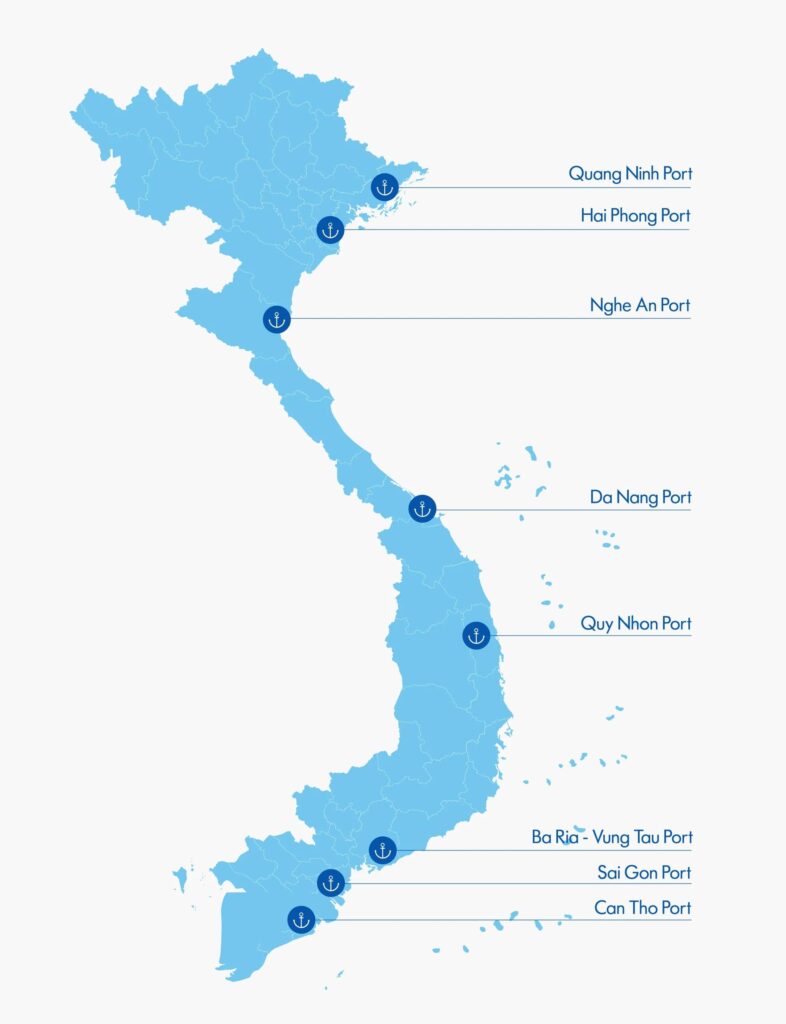사업 환경
A Comprehensive of Overview of Vietnam’s Ports across the Northern, Central, and Southern Regions
7월 1, 2024
Vietnam’s significant economic transformation over the past few decades has positioned it as a key player in international trade. Central to this transformation is the country’s robust port infrastructure, consisting of 34 port clusters spanning the entire length of the nation, from the northern provinces to the southern delta. These ports play a pivotal role in facilitating trade, connecting Vietnam to global markets, and driving economic growth.
Figure 1- Vietnam’s major container ports

Northern Ports: Gateway to China and Beyond
Hai Phong Port
At the forefront of Vietnam’s northern ports is the Hai Phong Port, a special-ranked seaport cluster comprising 52 ports and recognized as the second-largest port in the country. Of particular significance is Hai Phong’s Lach Huyen deep-water port, inaugurated in 2018. This modern facility has significantly enhanced the region’s capacity to accommodate larger vessels and handle increasing cargo volumes, with a maximum vessel capacity of 132,000 deadweight tons (DWT). Its strategic location in close proximity to China and direct shipping lines to vital markets such as the US and EU make it a crucial gateway for trade between Vietnam and its international partners.
Quang Ninh Port
Expanding further north, the Quang Ninh Port also plays a vital role in the region’s trade activities. Situated in Quang Ninh province adjacent to Hai Phong, this first-ranked port includes 5 berths, with a maximum vessel capacity of 85,000 DWT, serving as a key transportation hub for goods flowing between Vietnam and China, leveraging its strategic location along the border.
Central Ports: Strategic Link in ASEAN Connectivity
In central Vietnam, port clusters like Da Nang, Chu Lai and Quy Nhon serve as strategic links in the region’s economic landscape.
Da Nang Port
Da Nang Port, a first-ranked seaport cluster and the third largest in Vietnam, acts as a pivotal node in the East-West Economic Corridor, connecting Vietnam with neighboring ASEAN countries like Laos, Thailand, and Myanmar. With 8 ports whose maximum vessel capacity of 50,000 DWT, Da Nang Port facilitates trade flows and promotes regional integration.
Nghe An Port
Nghe An Port cluster is a first-ranked seaport in the Northern Central Coast of Vietnam. With a maximum vessel capacity of 30,000 DWT, it is located in an extremely advantageous position for international trade transactions, especially for transporting goods to Laos, Cambodia and Northeast Thailand.
Quy Nhon Port
Further south, Quy Nhon Port, located in the center of Quy Nhon city, Binh Dinh province, is a national multipurpose port, a regional hub of the Southern Central Coast. The first-ranked port can accommodate up to 30,000 DWT vessel and it is connected to over 10 sea routes extending to international ports such as Manila (Philippines), Singapore, Hong Kong, Kaohsiung (Taiwan), Bangkok (Thailand), Tokyo (Japan), Vladivostok (Russia), etc.
Southern Ports: Powerhouse of International Trade
Sai Gon Port
At the southern region of Vietnam lies the Sai Gon Port Cluster, a bustling hub consisting of 43 ports, such as Cat Lai Port or Sai Gon New Port that handles a significant portion of the Vietnam’s international trade. With a maximum vessel capacity of 58,000 DWT, Sai Gon Port Cluster serves as a critical gateway for imports and exports, facilitating trade with global partners and supporting Vietnam’s economic growth trajectory.
Ba Ria – Vung Tau Port
Additionally, the Ba Ria – Vung Tau Port Complex, which include Cai Mep – Thi Vai Port, are among the two special-ranked seaports in Vietnam. It stands out as a global contender in container port performance. Ranked 12th worldwide in the Container Port Performance Index 20221 by the World Bank, this complex boasts the capacity to accommodate larger container vessels, alleviating congestion in the area and enhancing the efficiency of Vietnam’s maritime logistics network. With a maximum vessel capacity of 100,000 DWT, it demonstrates Vietnam’s commitment to enhancing port infrastructure and driving economic competitiveness on the global stage.
Can Tho Port
Can Tho Port Cluster is a first-ranked seaport serving as the logistics center for the Mekong Delta Key Economic Region – the major manufacturing hub for agricultural and aquacultural products. Consisting of 2 major ports with a maximum vessel capacity of 20,000 DWT, Can Tho cluster is positioned as a connecting point between Vietnam’s Mekong Delta region, Southeast region and Cambodia. The port also accommodates exports to major markets like Japan, South Korea and the EU.
As Vietnam continues to chart its path as a dynamic player in the global economy, its ports will remain integral to sustaining and expanding its trade relations with partners worldwide.







